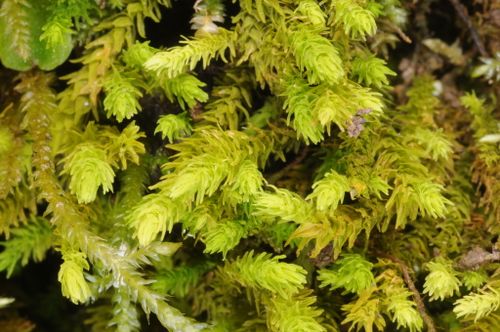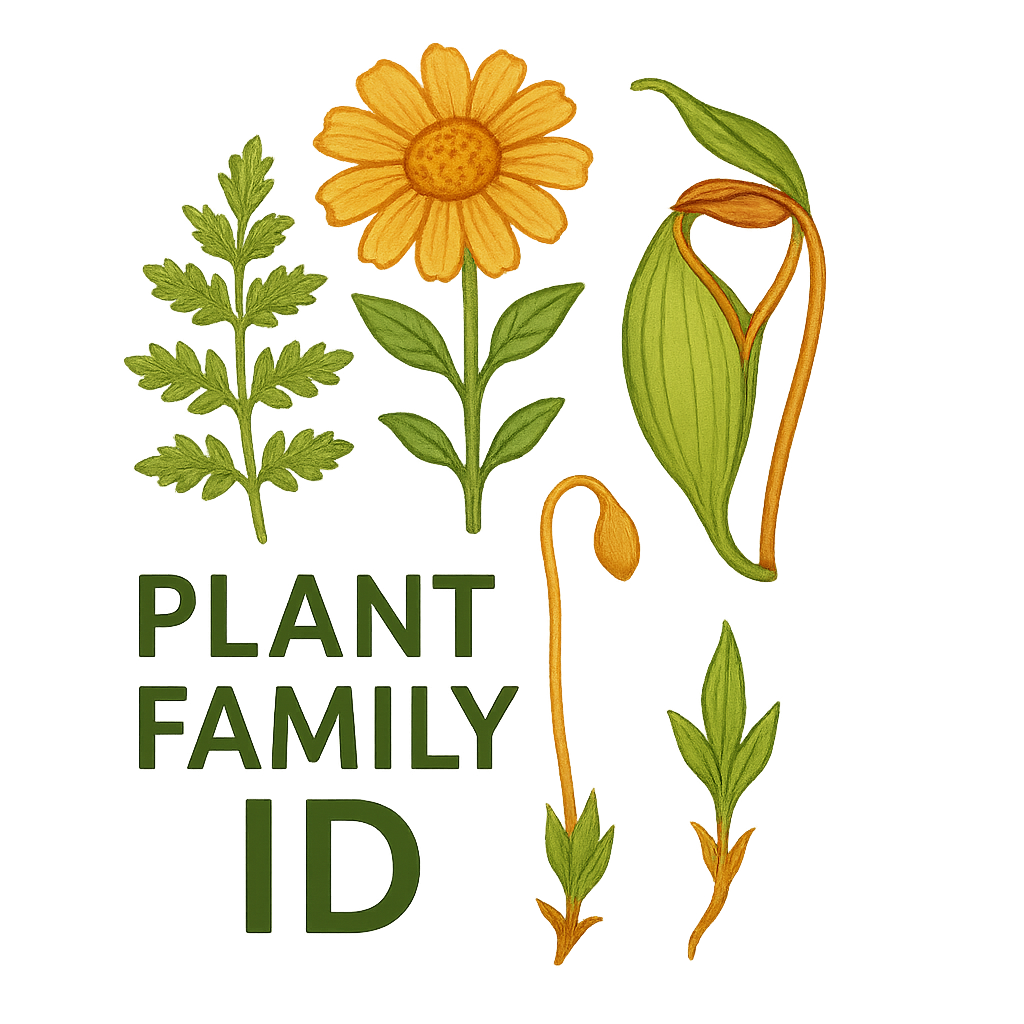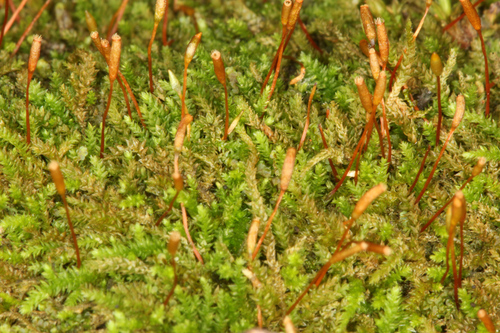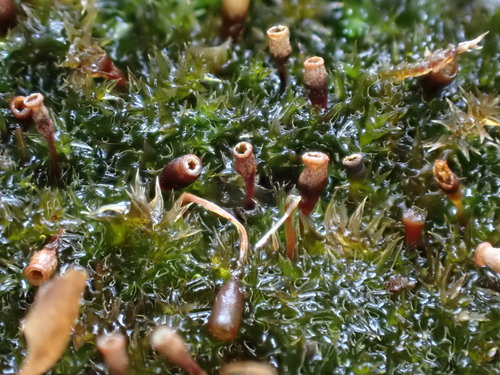Anomodontaceae
Anomodon Moss Family (Informal)
Anomodontaceae is a family of generally robust, pleurocarpous mosses belonging to the order Hypnales. The primary genus is Anomodon. These mosses are characterized by their often dull appearance (due to papillose cells), strong single costa ending below the apex, and preference for calcareous substrates in temperate Northern Hemisphere forests.

Overview
The Anomodontaceae family, established by Kindberg, centers around the genus Anomodon, with the inclusion of other genera like Herpetineuron sometimes debated (often placed elsewhere). These are typically medium-sized to robust pleurocarpous mosses, forming mats or wefts that often appear dull green, yellowish, or brownish due to papillose leaf cells.
A key characteristic is the presence of small bumps (papillae) on the leaf cells, usually multiple papillae per cell (multipapillose). The leaves typically have a strong single midrib (costa) that ends distinctly below the leaf tip. Plants often show differentiation between creeping primary stems and ascending secondary stems or branches, which can appear smoothly cylindrical (julaceous) when dry in some species.
Anomodontaceae predominantly occur in the Northern Hemisphere temperate and boreal zones. They show a marked preference for growing on shaded, calcium-rich substrates, such as limestone rocks, mortar, and the bases of deciduous trees in forests. The family is placed within the large and diverse order Hypnales.
Quick Facts
- Scientific Name: Anomodontaceae Kindb.
- Common Name: Anomodon Moss Family (Informal)
- Number of Genera: Primarily 1 (Anomodon Hook. & Taylor), others sometimes included.
- Number of Species: Several species in Anomodon.
- Distribution: Primarily Northern Hemisphere temperate and boreal regions.
- Evolutionary Group: Bryophytes - Mosses (Class Bryatae - Order Hypnales)
Key Characteristics (Moss Features)
Gametophyte (Leafy Plant)
The dominant stage. Plants medium to robust, typically dull (not glossy) yellowish-green to brownish, pleurocarpous, forming mats or wefts.
- Stems: Creeping primary stems give rise to ascending secondary stems or branches. Branches simple or sparsely branched, often appearing stiff, sometimes smoothly cylindrical (julaceous) when dry due to appressed leaves.
- Leaves (Phyllids): Crowded, often appressed when dry, spreading when moist. Typically broadly ovate, oblong, or lingulate (tongue-shaped), concave. Apex usually broadly acute, obtuse, or apiculate. Margins generally plane and entire or weakly crenulate/serrulate.
- Costa (Midrib): Single and strong, well-defined, ending distinctly below the leaf apex.
- Leaf Cells: Small, dense, typically isodiametric (roughly equidimensional) to shortly rectangular, thick-walled. Crucially, cells are usually multipapillose (bearing multiple small papillae on the surface), contributing to the dull appearance. Alar cells generally not strongly differentiated.
Reproductive Structures (Gametophyte)
Antheridia and archegonia are borne in lateral buds on the stems.
Sporophyte (Spore-Producing Structure)
Arises laterally from the gametophyte stem, often produced infrequently in many species. Consists of:
- Seta: Usually relatively long, smooth, often reddish or yellowish.
- Capsule (Sporangium): Typically erect and symmetric or nearly so, cylindrical to ovoid. Operculum usually conical or rostrate.
Peristome
Typically double and well-developed (hypnoid type), though variations can occur. Consists of 16 outer exostome teeth and an inner endostome, often with well-developed segments and cilia.
Field Identification
Identifying Anomodontaceae involves recognizing their habit, habitat, and key leaf features:
Primary Identification Features
- Dull Appearance: Plants typically lack glossiness due to papillose cells. Look for robust, yellowish-green to brownish mats.
- Habitat Preference: Strong association with shaded, calcareous (lime-rich) substrates like limestone rocks, mortar, or tree bases (especially deciduous trees).
- Strong Single Costa: Leaves have a distinct midrib that clearly ends before the leaf tip (use hand lens).
- Leaf Shape: Broadly ovate to tongue-shaped leaves, often concave with rounded or apiculate tips.
- Multipapillose Cells: The definitive feature (requires microscope), but contributes to the dull look visible in the field.
- Julaceous Branches (when dry): Branches may appear smooth and cylindrical when dry.
- Northern Hemisphere Distribution: Primarily found in temperate/boreal regions.
Common Confusion Points
- Thuidiaceae / Leskeaceae: These families also contain pleurocarpous mosses with papillose cells. Thuidiaceae are often more regularly pinnately branched (fern-like), while Leskeaceae can be variable but may differ in costa length or leaf shape.
- Hylocomiaceae: Includes large, robust pleurocarps like Hylocomium splendens (Stair-step moss), but these are usually pinnately branched in a different manner and have smooth or unipapillose cells.
- Amblystegiaceae: Some members can grow on rocks or tree bases but often prefer wetter habitats and typically have smooth leaf cells and different leaf shapes/costa lengths.
- Neckera / Metaneckera: Can grow on similar substrates but are usually strongly complanate (flattened) and often have different costa or cell structures.
Field Guide Quick Reference
Look For:
- Robust, dull (not glossy) moss mats
- Pleurocarpous habit
- Habitat: Calcareous rocks, tree bases
- Leaves broad, concave
- Strong single costa ending below apex
- Multipapillose cells (dull look)
- Branches possibly julaceous when dry
- Northern Hemisphere
Key Variations:
- Degree of branch stiffness/julaceous appearance
- Precise leaf apex shape
- Frequency of sporophytes
- (Variations exist among Anomodon species)
Notable Examples
The family is best known for the genus Anomodon:

Anomodon attenuatus
Anomodon Moss
A common species, often forming extensive mats on tree bases and rocks. Characterized by slender, tapering (attenuate) branches that are often flagelliform (whip-like). Leaves are papillose with a strong costa ending below the apex.

Anomodon viticulosus
Long-leaved Anomodon
A robust species, typically larger than A. attenuatus, with broadly tongue-shaped (lingulate), concave leaves that are strongly papillose. Often found on shaded limestone rocks or walls.

Anomodon rostratus
Beaked Anomodon
Distinguished by its leaves which have a more abruptly pointed or beaked (rostrate) apex compared to other common species. Also found on calcareous substrates.
Phylogeny and Classification
Anomodontaceae is classified within the Class Bryatae (true mosses) and is placed in the large order Hypnales. Historically, its relationships were sometimes debated, with associations suggested with Leucodontales or Leskeales due to shared features like papillose cells or epiphytic habits.
Modern molecular phylogenetics generally supports its placement within Hypnales, often showing affinities with families like Thuidiaceae and Leskeaceae, which also feature papillose cells but differ in branching patterns, leaf shapes, and other characteristics. Anomodontaceae represents a distinct lineage within the pleurocarpous mosses, adapted primarily to shaded, base-rich environments in the Northern Hemisphere.
Position in Plant Phylogeny
- Kingdom: Plantae
- Division: Bryophyta (Mosses)
- Class: Bryatae (or Bryopsida)
- Order: Hypnales
- Family: Anomodontaceae
Evolutionary Significance
Anomodontaceae represents a successful lineage of pleurocarpous mosses specialized for base-rich substrates in temperate forests. The development of multipapillose leaf cells is a key feature, likely influencing water relations and providing a dull appearance, perhaps reducing photoinhibition or deterring herbivores. The family's distinct morphology and ecological niche contribute to the overall diversity within the Hypnales order.



